How to store gladiolus bulbs?

Gladiolus belongs to the perennial garden plants of the iris family, which are today grown exclusively for ornamental purposes. Unlike other perennials, corms of gladioli do not tolerate prolonged frosts, and therefore need shelter for the winter period. This article will discuss how to properly store gladiolus bulbs.
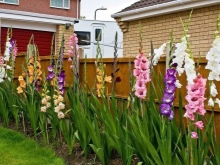
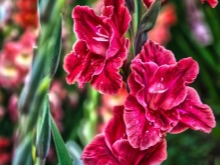

Why dig up for the winter?
This question is usually asked only by inexperienced summer residents - seasoned gardeners know that for a gladiolus, the process of digging out tubers is quite natural and even obligatory. Everything is explained by the low resistance of these plants to temperatures below -3 degrees Celsius. It is this indicator that is considered critical for gladiolus bulbs - if the soil temperature is lower, they die, becoming completely unsuitable for further planting.
So that the corms during the winter period are preserved and not rotted, they are usually stored at home - in a cool room - until the next spring.
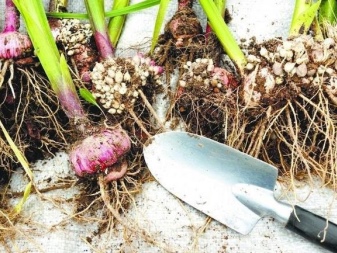

Optimal cleaning times
To preserve the tubers of gladioli, it is important, first of all, to dig them out of the garden at the correct time. It is believed that the best time to dig up the bulbs comes 1-1.5 months after the beginning of the flowering period. Usually, depending on the type of flower, this occurs in autumn - late September and early October. It is not recommended to delay the excavation of tubers, for the autumn period is characterized by sharp temperature changes that can have a detrimental effect on the condition of the bulbs.
And also the timing of harvesting can be guessed by the external state of the corms - for example, if characteristic scales are visible on the bulb, then such a tuber is immediately dug out.
Gardeners advise to dig up gladioli after the potatoes have been harvested in the garden, but the cabbage has not yet been harvested - unfortunately, this advice is very approximate, since each summer resident uses different varieties of these vegetable crops with a different harvest period.
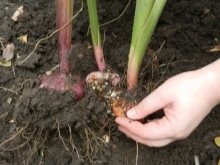
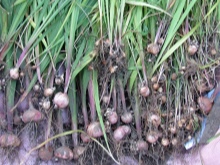
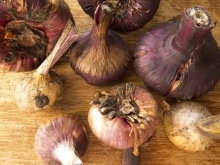
Preparing the bulbs before storage
The process of preparing corms before storage at home includes several separate stages.
Collection
To properly harvest the bulbs, you will need a wide garden shovel and a disinfected pruner. Also, do not forget to prepare a large container for collecting the bulbs. During the digging process, pay attention to a number of factors.
- It is best to dig up the bulbs in warm, dry weather - in such conditions, you can easily pull the tubers out of the ground. Dryness of the soil is especially important when digging up children, since it is problematic to collect them in wet soil. And if they stay there for the future and survive the winter, this may lead to the crossing of varieties of gladioli in the flowerbed. In addition, if the bulbs are harvested wet, it is likely that they will rot.
- In order not to harm the bulbs during harvesting, step back about 15-20 cm from the intended place of collection of the corms. While digging, lightly hold the earthen ball with your hands - usually there are a lot of children underneath, which will be an excellent seed in the future.
- After digging, each bulb, as well as its roots, is shaken off the ground, and the stem of the plant itself is shortened to a height of 15-20 cm.If removing all the soil from the bulb does not come out, clean it with regular summer temperature water.
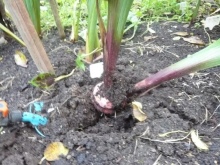

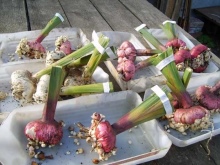
Selection of planting material
The next step is to remove all affected, spoiled or damaged bulbs with a shovel. It is better to isolate them from plants and burn them. Pay special attention to tubers affected by larvae and worms - they can be seen by the characteristic moves in the bulbs.
Corms that were damaged during the digging process can be treated with a solution of potassium permanganate, as well as wood ash. This will prevent the bulbs from rotting during storage.
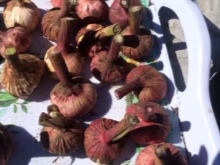
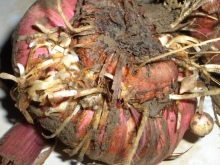
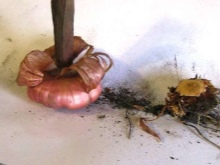
Drying
Many gardeners resort to additional drying of gladioli tubers before storage - this will allow the bulbs to survive better in winter and destroy some pests that could get under the husk. Usually, special dark containers are chosen for drying - standard boxes for collecting vegetables and fruits are best suited for this.
The temperature in the drying room should not fall below +22 degrees - in approximately such conditions, the bulbs will have to stand for about a month (sometimes one and a half). After that, the old skin is removed from the bulbs, and the side children and roots are also separated. The stem of the gladiolus can be twisted or trimmed. Before the spring planting in the ground, the bulbs are placed in paper bags or cardboard boxes.
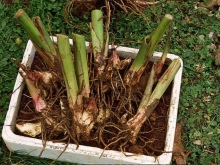

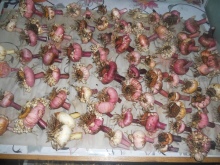
Treatment
The processing of bulbs is a recommended procedure before storing gladioli tubers. It allows you to protect tubers from fungal diseases that can be transmitted during storage from other vegetables.
Before finally sending the tubers for storage, they are treated with disinfectants like Inta-Vira, Maxim, or Homa. After processing, the tubers are given a little time to settle, and then they are placed in a storage area.
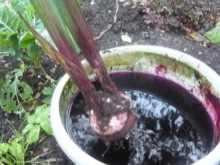
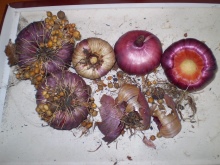
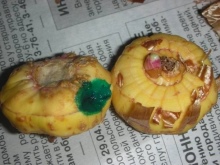
How to save?
There are several common options for preserving gladioli bulbs during the winter. In most cases, gardeners prefer to store tubers in an apartment or indoor environment, or in a cellar / basement. Below we will consider the features, pros and cons of each of the options for such storage.
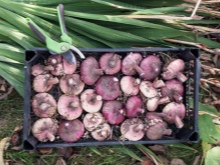

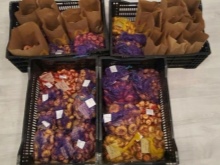
In the apartment
If you want to store gladiolus tubers in a city apartment there are several convenient areas and storage areas:
- in the restroom near pipes and communications that supply cold water;
- on the loggia, which must be glazed so as not to let in cold air;
- in a closet or on a mezzanine without heating elements, but with good ventilation;
- driveways;
- the classic option is openings in windows or doors.
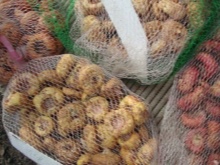


Regardless of which storage location you choose, certain requirements must apply to it.
- Complete absence of drafts and cold air. That is why options such as open loggias or window sills near wooden frames are not suitable here.
- Stable temperature level, which will not fluctuate much around 5-7 degrees.
- Indoor humidity should be kept at 60-75%. Because of this point, tubers are not recommended to be stored in bathrooms or steam rooms, as well as in the kitchen, near sinks and stoves.
- The storage area should be slightly shaded and dry, but also well ventilated.
- If a standard drawer is selected for storage, it should not be placed simply on the floor in the room. Panels made of boards are installed under the box, which will provide good ventilation. If you chose paper bags for storage, then you need to make several holes in them for air circulation.
- When stored in containers without holes, the onions are laid out on a layer of clean paper, and then sprinkled with sand, previously disinfected in the oven.

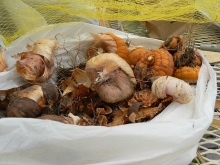
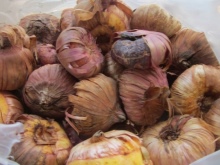
If there is a sharp drop in temperature in the room where the tubers are stored, the container with the bulbs can be equipped with a special insulated box. To keep track of the optimal temperature, a thermometer is installed in the box. The simplest option for insulating a box with gladioli would be to simply cover the container with tubers with warm clothes or fur coats. In this case, the container, again, must be ventilated.
During storage, do not forget to monitor the condition of the tubers from time to time. - bulbs that begin to rot or mold must be immediately removed from the container. If the damage or spots on the tubers are minor, pruning with a disinfected pruner should be done. At the same time, all cut points are treated with a solution of potassium permanganate so as not to provoke rotting.

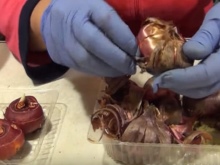
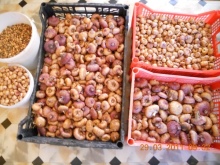
Storing corms in the refrigerator is considered by some gardeners to be the best option for several reasons.
- You can view the bulbs at any time and assess their condition.
- In a refrigerator with thermoregulation, it is possible to more subtly approach the temperature setting. In addition, there will never be temperature jumps here.
- To adapt the tubers for planting in open ground, the temperature in the refrigerator can be gradually lowered, thereby hardening the gladiolus bulbs.
Typically, the tubers are stored in the vegetable compartments of the refrigerator. In this case, the bulbs are divided into varieties and wrapped in newspapers. Every month the condition of the bulbs is checked and the frozen or damaged newspaper is replaced with a new one.
Never store bulbs in the refrigerator compartment in plastic sealed containers. Bacteria regularly accumulate there and there is no ventilation.
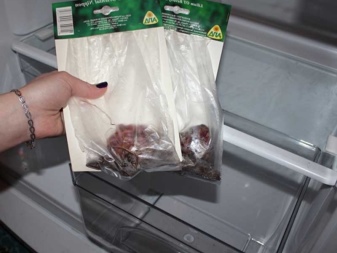

In the basement
If there is no suitable place in the apartment for planting gladioli tubers, gardeners can resort to using a basement or cellar. Some conditions are also imposed on this storage method.
- The cellar should be not only cool, but also dry - buried options are not suitable here, where moisture constantly accumulates on the floor.
- In addition to gladioli bulbs, no other vegetables should be stored in the cellar. Potatoes, beets or carrots, which are usually stored in basements, are capable of releasing a huge amount of moisture, causing gladioli to rot.
- As in the case of storage in an apartment, the temperature level in the basement should not exceed + 4 ... 7 degrees Celsius. Moisture readings are also identical - from 60 to 80%. The only exceptions in this case are children and young bulbs - just cool rooms with an even higher level of humidity are more suitable for storing them.
- Ventilation is the main factor that affects the suitability of the cellar. If the room is regularly ventilated, and the storage container is equipped with holes or a net in which the bulbs are placed, then this basement option will be optimal.
As an alternative to the cellar, an ordinary garage can become a storage place for tubers.

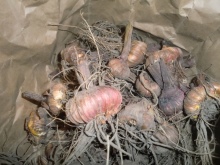
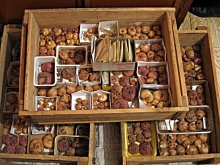
How to protect tubers from diseases and pests?
The best way to protect gladiolus tubers from diseases and pests is to carefully examine the bulbs during harvest, as well as regular preventive examinations during storage. This will eliminate diseased flower bulbs at the very first stages of storage.
Most often, when storing gladiolus bulbs, gardeners can face only two difficulties. The first is the so-called gray mold - it is expressed in the appearance of characteristic gray spots with fluff on the flower tubers, which very quickly increase in size. At the same time, the tubers lose weight and become viscous. The cause of this disease is too high a level of humidity, lack of quality drying, or irregular ventilation.
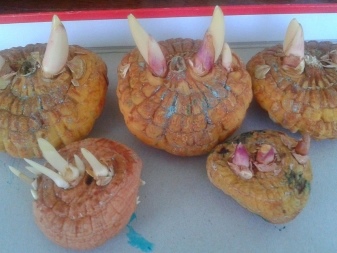
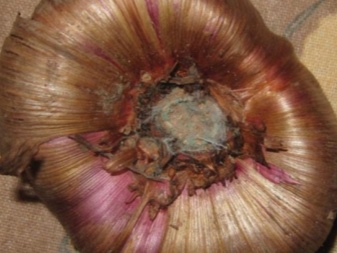
The appearance of thrips (or tiny black insects) on the tubers of gladioli is the second possible complication, which usually manifests itself in the complete drying of the bulbs and the appearance of dark passages on the tubers. Tubers affected by this pest can be difficult to identify during the collection of the bulbs - the larvae of thrips are taken under the very husks of the bulbs, where they hibernate with them until spring. In favorable conditions, insects wake up and begin to simply drink the juices from the bulb.
To avoid the appearance of thrips, tubers must be treated with insecticides before storage. A good remedy for thrips will be dusting the bulbs with powders from ordinary cockroaches. This procedure can be carried out 2 times - the first time before winter storage, the second time in the first week of January. Alternatively, the tubers can be treated with a solution such as Tom.
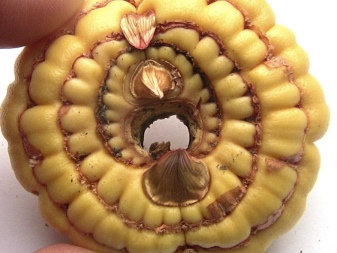

If the tubers of gladioli are already infected with thrips and the pests cannot be removed manually, you can resort to more radical treatment and care. For this infected tubers are placed in a separate sealed container. Then plastic covers are laid on them, and on them are cotton wool dipped in a solution of medical alcohol (best of all, 96%). This procedure is best done 2 times with a break of 4 days. After such disinfection, the tubers will no longer carry any danger - they are dried and placed next to the rest of the bulbs.
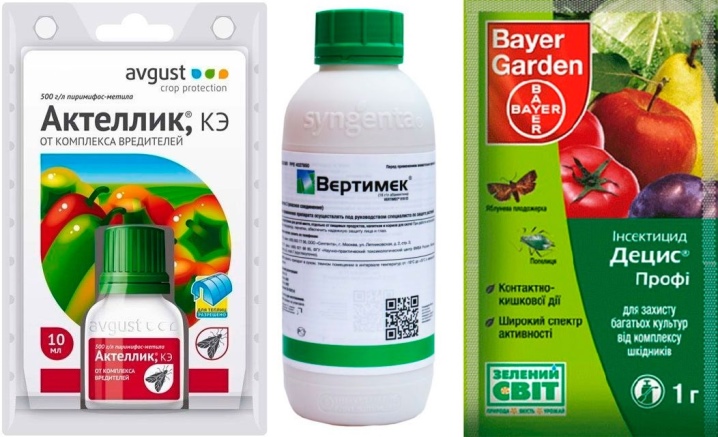
Frequent mistakes
Novice gardeners, when storing gladioli corms, sometimes make certain mistakes that can affect the immunity of flowers or even lead to its death. Typical error situations will be discussed below.
- Storage in the bathroom. Some growers consider the bathroom to be the optimal place for storing gladioli tubers - in these rooms, indeed, the optimal temperature regime is noted, however, with the humidity level, everything is not so simple. With regular use of the bathroom, air humidification can sharply jump and decrease, which ultimately will lead to rotting of the corms.

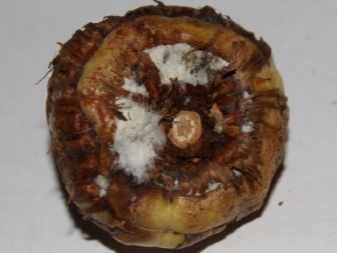
- Uneven collection. During harvesting of planting material from the garden, it is necessary to collect ripe and ready-to-harvest bulbs. Usually gardeners do not bother and choose tubers of absolutely all gladioli from the site, not taking into account the individual flowering periods of different varietal crops. In order not to get confused in the varietal variety, it is better to plant gladioli in a flower bed in separate varietal groups. From the beginning of the flowering of the gladiolus to the collection of the bulbs, at least 30 days must pass.
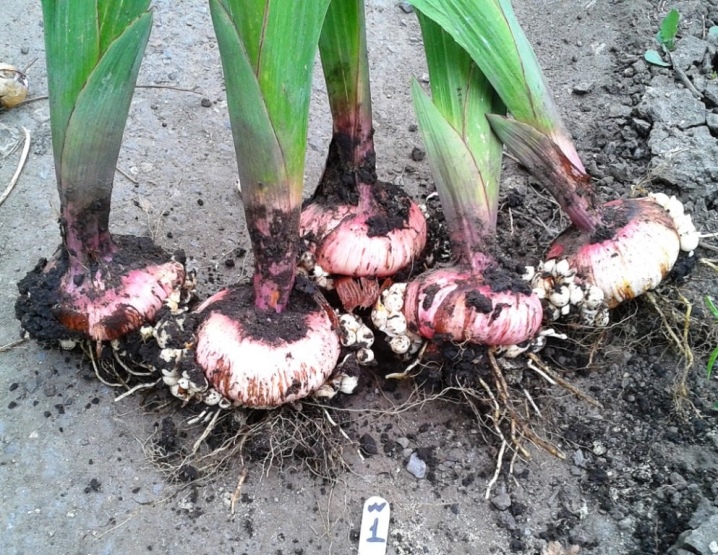
- Removing the husk. When digging gladioli tubers, many summer residents prefer to remove the husk from the bulbs, not considering that it protects the plant from the cold and prevents the bulbs from drying out. The husk is removed only after drying, if it simply hangs from the tubers, or if the corms are treated with paraffin.

- Storage in packing bags. As already mentioned, the container for storing flower bulbs must be constantly ventilated. Even if holes are made in the plastic bags to allow oxygen to escape, due to the structure of such bags, they will not provide a good air passage. As a result, the bulbs will suffer from oxygen starvation.

- Direct sunlight. Those who prefer to store gladioli tubers on the windowsills on the south side of the house are making a big mistake. Bulbs of these flowers really love good and constant lighting, but the light should not be directed - the direct rays of the sun will simply dry them out and make them completely unsuitable for planting.
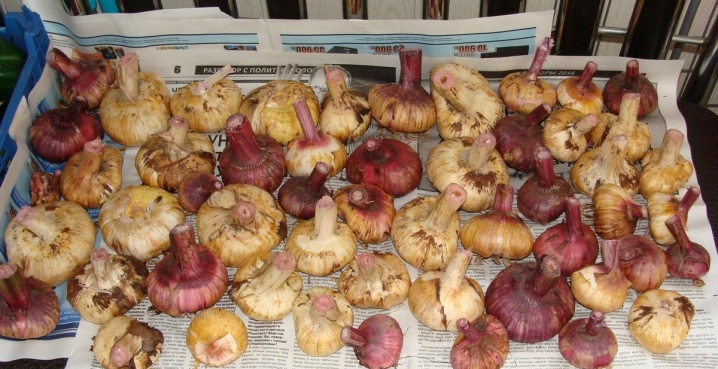
- Storage in one container. One of the serious mistakes is the storage of assorted gladioli bulbs in one container. In this case, the gardener risks not only confusing gladiolus varieties, but also provoking the rapid spread of a fungus or virus from one tuber to all others.
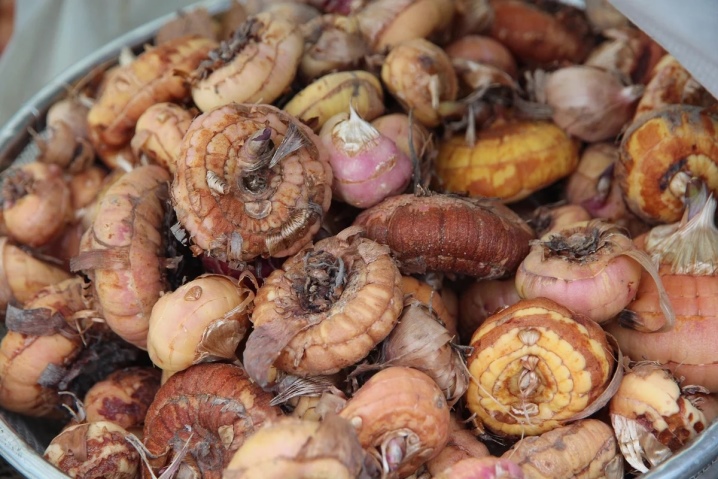
- Ignoring the signs of the disease. Unscrupulous selection of suitable and healthy planting material is one of the most important causes of bulb rot in gardeners.
Remember that the infection does not stand still and develops very quickly, but dangerous pests can not only harm the bulb, but also be carriers of dangerous viruses that cannot be cured.
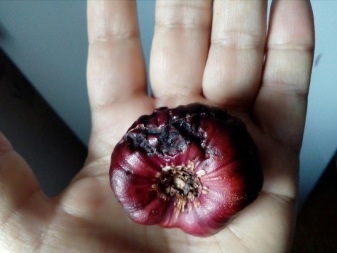
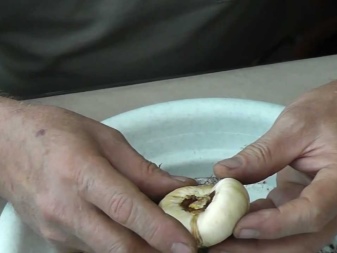
Next, watch a video with expert advice on when to dig up and how to store gladiulus bulbs.







































































































The comment was sent successfully.